Music
Dancing on Top of the Cars
The Fireballs drove two cars out of Ratón and went to Number One in America.
Story & photographs by Tim Keller
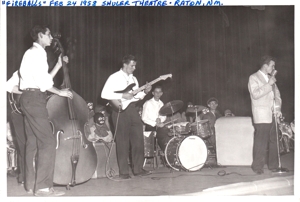
In January 1958, George Tomsco talked his best friend Stan Lark into joining an unnamed little combo for the annual PTA talent show at Ratón High School. “There were some other guys in high school that had bands, too, but we just kinda came out of the woodwork and went bam!” Lark recalls. “And we won it!” Tomsco adds. “From there on, it was straight up.”
They caused such a ruckus in the high school gym that day that they were called back for an encore. “The only rock and roll song we knew was ‘Great Balls of Fire’ so we did it again,” says Tomsco.
They were on to something. They quit playing country music and named their new band The Fireballs. In Elvis Presley’s wake, rock and roll was changing the cultural landscape. “We were the only band within 200 miles playing rock and roll,” says Lark. By the time they graduated from Ratón High School that spring, they were playing to wildly enthusiastic crowds at Ratón’s Shuler Theater and throughout northeastern New Mexico.
Tomsco was astonished to discover that radio hits by Buddy Holly, Roy Orbison, Buddy Knox and others were recorded right here in New Mexico at the Norman Petty Recording Studios in Clovis. He called and talked to Petty himself, requesting an audition for The Fireballs. He still remembers the phone number. “Norman was really nice and said to send him a tape recording, but we didn’t have a tape recording so I fibbed and told him we were going to be playing down near Clovis in two weeks, that we’d rather just come play for him.
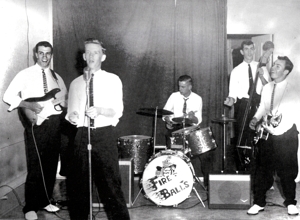
“I quick booked us a gig at Rigoni’s in Roy for the Saturday night on the way down. We made $200 there. We set up at Petty’s studio on Sunday. We couldn’t audition until 2 o’clock because the Pettys went to church.”
They expected Norman Petty to be much older. They kept practicing even as they noticed a young man enter the control booth. Petty eventually came out to introduce himself. “I’ve been listening,” he said. “Do you have any original music?”
“What’s that?” Tomsco recalls saying.
“Anything you’ve written yourself.”
The 18-year-olds played Petty an instrumental called “Fireball” that Tomsco had made up to showcase his electric guitar playing, backed by Lark on bass, Eric Budd on drums, and Dan Trammel on rhythm guitar. They did a second song to feature their singer Chuck Tharp.
Petty had Buddy Holly sessions scheduled for Monday and Tuesday. He scheduled The Fireballs for Wednesday, September 3, 1958. Lark was scheduled to start college at NMSU on Monday. He never went. Tomsco had already started at NM Tech; he quit. They spent their money on a motel and food to stay in Clovis until Wednesday, when they made their first record.
Returning to the studio from a dinner break at Foxy’s Drive-In, they found a pink Cadillac with Texas plates parked outside. As Tomsco entered the control booth and peered through the studio glass, he got upset to see a guy in a white t-shirt and jeans playing Tomsco’s guitar, his foot on Tomsco’s amp. “Who’s that?” he demanded of Petty. Petty replied, “Buddy Holly.” The Fireballs were star struck – Tomsco says he got “lockjaw” – but they all shook hands and visited with the big star that was about to move to New York.
Petty got “Fireball” released on Kapp Records in January 1959. It went to Number 90 for one week, and then disappeared. But the boys were hooked. Tomsco wrote more instrumentals; Petty recorded “Bulldog” and “Torquay,” then sent the band to T.B. Skarning, an agent who booked big Midwestern tours.
“We drove up to Skarning’s house in Minneapolis in two cars, Lark’s 1950 Buick Roadmaster and Eric’s 1953 Ford Starliner,” Tomsco says. “Skarning put us out on tour playing ballrooms and dance halls. Every town had one.”
“We were driving in Minnesota,” Lark adds, “when we first heard ‘Torquay’ come on the radio, and we thought, Wow! We stopped to listen. I think that’s the most excited I’ve ever been. We were almost dancing on top of the cars.”
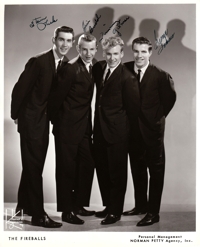
“Torquay” launched The Fireballs’ national career. “It took off like a rocket!” Lark says. By January 1960 they were in Philadelphia to appear on Dick Clark’s television show, then New York City for more TV appearances. Petty recorded their first long-playing album, The Fireballs, an even mix of original instrumentals and vocals. And then, one by one, the other three members left the band, returning to Ratón.
Tomsco and Lark lived in the apartment behind Petty Studios in Clovis as they replaced band members and The Fireballs became Petty’s house band, even adding tracks to unfinished Buddy Holly songs after Holly’s death. Petty played matchmaker, finding an Amarillo singer the same age as Tomsco and Lark. Jimmy Gilmer became the voice of The Fireballs throughout the 1960s as the band recorded hit after hit at Norman Petty’s Clovis studio.
Lark was convinced that one song was ruined when Petty himself added a kitschy 20-note riff on a little Hammond Solovox – a short keyboard attached to a speaker – but he was glad to be proven wrong. Complete with a pre-Starbucks homage to “espresso coffee,” the loping, infectious “Sugar Shack” topped Billboard Magazine’s national sales chart for five weeks in the fall of 1963, becoming the number one single for the year. It’s an accomplishment no New Mexico band has equaled.
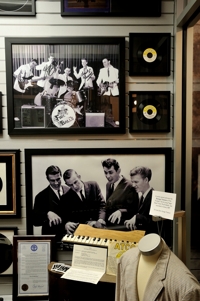
Other songs charted well, including “Daisy Petal Pickin’” at number 15 and “Bottle of Wine” at number 9, along with more of Tomsco’s twangy guitar instrumentals like “Vaquero” and “Gunshot.” Tomsco’s instrumentals sounded a lot like the “surf music” popularized by The Ventures, whose hits started charting a year after The Fireballs’ success with “Torquay.” Of course, it’s a long way from Ratón to the nearest surfing beach.
By 1972, Gilmer and Lark had left the band, leaving Tomsco to carry on with just his guitar and replacement players. He sold insurance for a few years; Lark did technical work for local coalmines. When original singer Chuck Tharp rejoined Tomsco in 1989, Lark followed. The three original Fireballs performed from 1990 until Tharp’s death in 2006.
Fifty-five years after the first gig, Tomsco and Lark still play a handful of main stage Fireballs concerts around the country each year, now as New Mexico’s energetic rock and roll legends. Jimmy Gilmer, today an artists’ manager in Nashville, joins them for a couple shows each year.
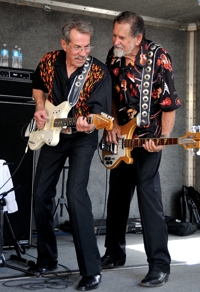
Joined by drummer Chris Segura and keyboardist Paul Goad, Tomsco and Lark’s Fireballs rocked a whole block of downtown Albuquerque at last June’s Centennial Summerfest. Dressed in black pants and shirts that looked like they were on fire, The Fireballs laid down a groove that quickly filled 6th Street for a half block to Central Avenue. The crowd danced in the streets. As Tomsco rocked his signature swinging guitar lines, he couldn’t help but smile every time Lark matched his moves step for step. Like a pair of 18-year-olds who have just discovered the joys of rock and roll, the two friends sent the joys reverberating all the way down the street.